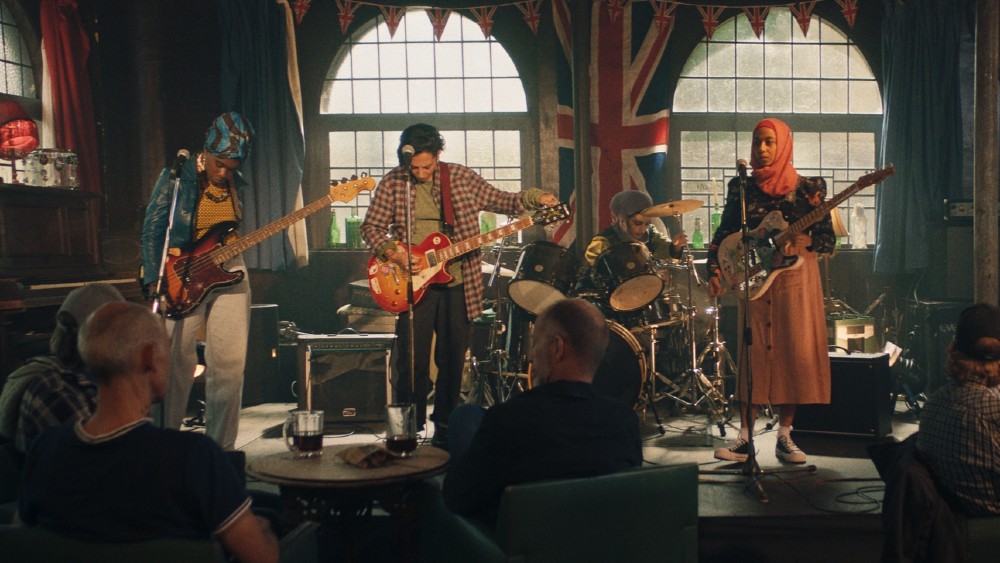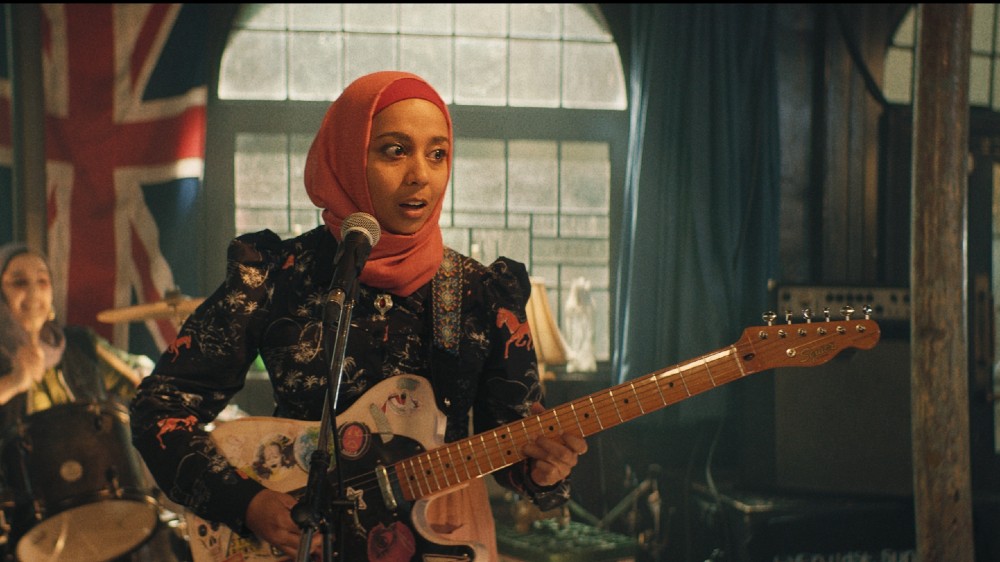
Four Muslim women form a punk rock band in We Are Lady Parts, a six-episode comedy which began streaming on Peacock in June. Written and directed by Nida Manzoor, the series takes a hard eye at Muslim stereotypes, at the same time offering knowing takes on demanding parents, “Mean Girl” coeds, and the terrors of dating.
Anchored by terrific performances — especially Anjana Vasan as Amina, a painfully shy PhD candidate in microbiology and Sarah Kameela Impey as Saira, the estranged daughter of strict parents — We Are Lady Parts has a brash energy heightened by pop sensibilities. The series veers from DIY bashing to sedate engagement parties, from kitchen-sink realism to pastel animated sequences.
Great Britain’s Channel 4 commissioned We Are Lady Parts after a short pilot was filmed in 2018. Diana Olifirova was Director of Photography on the pilot and was hired for the subsequent series. She won the British Society of Cinematographers Emerging Cinematographer’s Award for the short film All Of Me (directed by Daphne Schmon) and recently wrapped principal photography on Netflix’s upcoming Heartstopper, based on the graphic novels by Alice Oseman.
Olifrova spoke with Below the Line on Zoom from London.
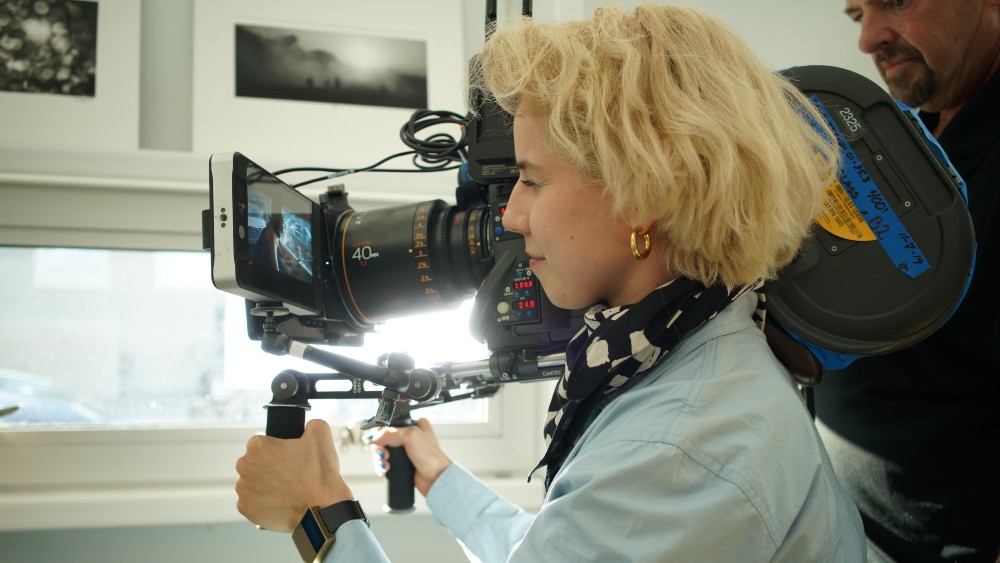
Below the Line: How did you get on this project?
Diana Olifirova: I shot the pilot, which was just a 15-minute thing, what Channel 4 called a “block,” and it did so well on YouTube that they commissioned a show. Nida wanted to use the same team she had on the pilot, so Simon Walker came back as Production Designer, P.C. Williams as Costume Designer.
Nida is very open to our ideas. We inspire each other, bounce things off each other. For example, I wanted to use a lot of mirrors. That’s not something that cinematographers usually use — they get in the way of the camera — but I really like how they enhance the depths of images. So Simon got excited about implementing them, and then Nida saw the results and kind of pushed them even more. Things like that, you know, expanding on ideas, it all contributed to really nice collaborations.
Below the Line: What was your schedule like?
Olifirova: We had nine weeks. First a four-week block, then a break, then another five weeks. We started tech reccies in March, 2020. All of our planning suddenly fell through because of the COVID shutdown. We had the whole summer to ourselves, working on the script and developing the story further. It was really weird without a definite timeline. It felt like an endless stress test.
I always feel that it’s important to know when to stop, because you can just keep changing ideas. Sometimes it is important to have that pressure. We got greenlit again in September, when we had to figure out how to work within the COVID guidelines.
Below the Line: How did the protocols affect you? We Are Lady Parts is filled with concerts and crowd scenes.
Olifirova: That was a limitation. Originally, we would have had a lot more people. Instead, we used fewer people, and they had to be tested quite precisely. It was a long, tedious process. Lots of scenes we set indoors we ended up shooting outside. Like the final gig, a night scene, that was shot right next to our studio because we saw this cool industrial estate on the way to the parking lot.
We had built some locations, and then decided to build a lot more because we could have more control. There would be fewer people with masks in the backgrounds.
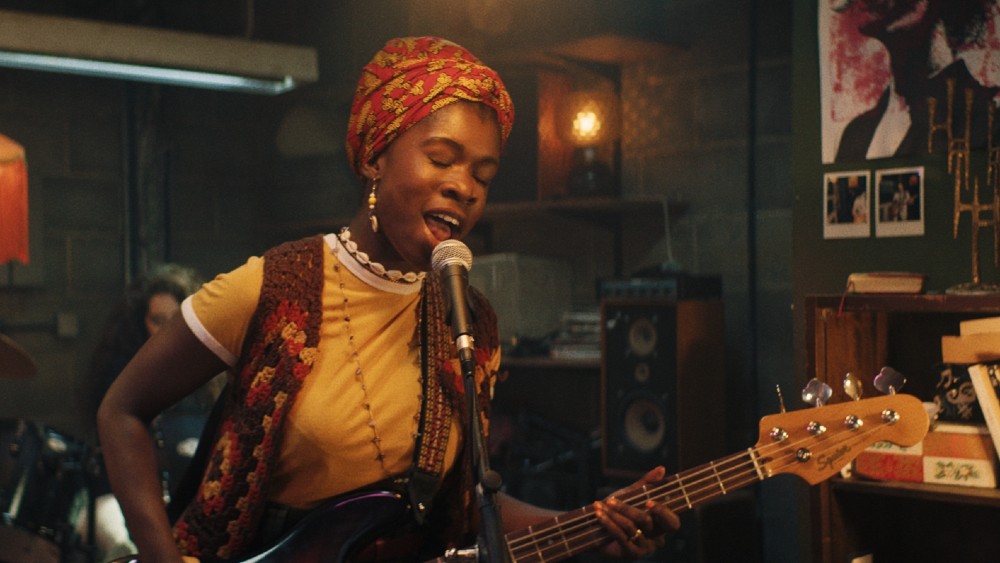
Below the Line: How did you shoot the songs? Did they work from prerecorded tracks?
Olifirova: They had prerecorded tracks for rehearsals, but we shot the songs themselves live. They would sing it live every take.
Below the Line: How did that work? Would you shoot them individually straight through and then go back and focus on another musician for the next take?
Olifirova: Sometimes, yeah. Mostly we focus on the two main musicians, Amina and Saira. Then we would do an overall pass throughout the song with a closeup lens, then another pass with a different lens, for a wider shot. Then another pass for slow motion, for example. Amina also has a couple of songs she sings solo, she would sing those live.
They rehearse four or five songs in Saira’s bedsit. We wanted to make them all look different, but they also have to be realistic, because you don’t want to go too far out. Although sometimes I would be like, why not add some color? Why not try this? Why not try to make it more dynamic? See how much I can push to make them more like pop music videos.
Nida was always open to explore colors, dynamic movements, things like that. I tried to do each song in different styles, with different lenses, colors, make them more dynamic, less dynamic. We had lights come through the roof to hit the characters, because we wanted wide shots and there wasn’t much room for lights. We had a lot of things to play with.
Below the Line: How did you shoot Amina’s two solo songs? In the first, she’s accompanied by puppets.
Olifirova: She’s in a wardrobe for the first, and in the script it said something like “The wardrobe extends forever.” We built a real wardrobe, a very long one that transitioned from one set to another. They wanted the camera to follow her into it, so I thought we could do it on a track with Anjana on an extension of the dolly platform. I thought, “Why not add a bit more movement within it, so viewers could get completely lost?” I put the camera on a slider, and then I could also do contra zoom while we’re moving together. Try to connect to the rhythm of the song. I feel when the camera is moving in the right rhythm, it really gets the audience into the song. So I enjoyed trying to play around with those contra zooms and dynamic lighting and all those things together.
Her second song, “Creep,” she steps onto a big dolly platform and then we dolly back on wheels. We had two crew with handheld LED lights on dimmers as she moved. It was like a DIY approach to VFX, do the effects for real.
Below the Line: That’s Anjana’s best performance in the show, it must have been tough to pull together all the elements live.
Olifirova: Also not be distracting. Ideally be quiet. When you do something like that, a really long take, everybody has to be on it, everybody’s in the zone, working together towards one thing. You feel an energy.
Below the Line: Another difficult sequence was the poetry read. You’ve got to cover two very different performances, plus move through a crowded audience.
Olifirova: That was my favorite location, I really loved the space. Something about it made me feel creative, maybe the backdrop or the columns. It had this intimacy which inspired me to light it that way.
The first poem is by Saira, it was meant to inspire Amina. So I wanted a small Steadicam approach, kind of elaborating on the poem. As you get closer to Saira she gets more emotional, but in a smooth way. It was challenging because a lot of people were in the way, they all had to lean out as the camera came by. It was quite a low ceiling, so it was hard to avoid camera shadows.
For Amina’s poem, it was all handheld, a very different feel. I also went to a very wide lens to make it feel very uncomfortable, like the world is falling apart. I had to come in very close but also make her feel like I wasn’t there.
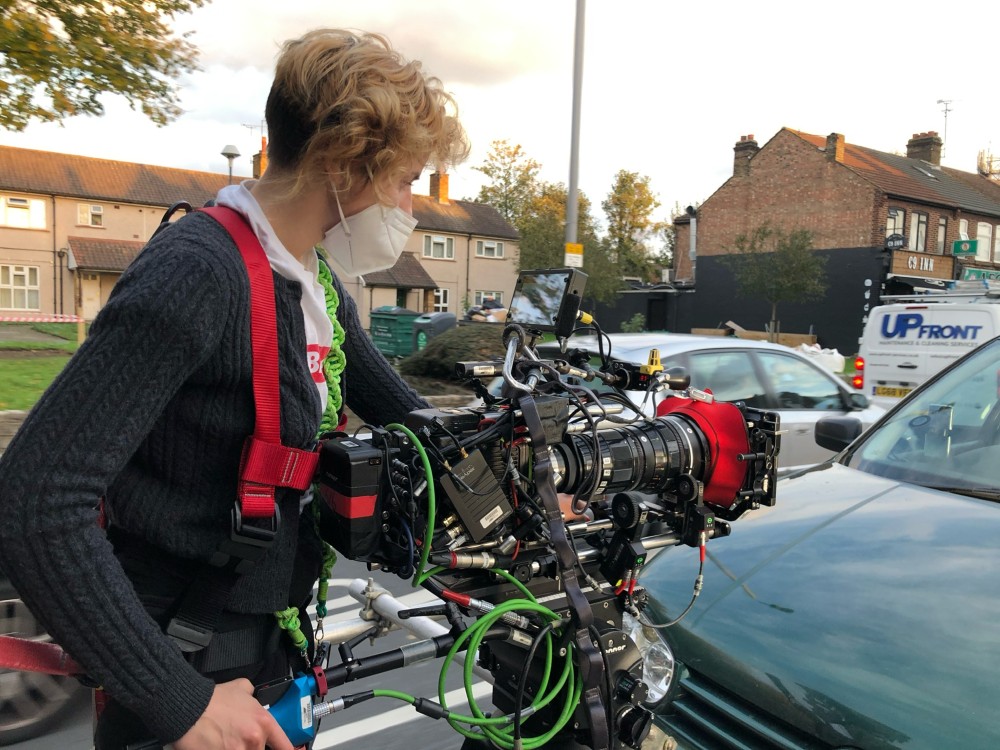
Below the Line: What was your camera package?
Olifirova: ARRI Alexa Mini with two anamorphic lenses. For lighting we had lots of different things, a studio kit, a location kit. For the studio, big-time lights, beams through the windows to create a warm feeling of sunshine. Lots of LEDs we could program. For locations we mainly used HMI’s.
I really like hard light, so I didn’t use much diffusion. Lighting can play a role revealing character. We shouldn’t be shy about showing the face rather than trying to constantly soften it with makeup and diffusion.
I like to explore, use a lot of different colors. I ordered a bunch of different gels, first starting from the production designer’s palette and then also random ones, just to have something to play with. One day try this gel, try that gel. Somehow it all comes together.
Below the Line: Do you operate the camera?
Olifirova: Yes, handheld and all the rest, apart from Steadicam and crane shots. I love handheld, it’s my favorite. Nida wanted me to operate the handheld — she says I bring something to the image when I operate. I feel like I do connect so much to the characters.
Below the Line: How does that connection translate into imagery?
Olifirova: It feels like I can predict what they’re going to do or where they’re going to go. I kind of become invisible in a way. I feel like the camera is a character and it’s in sync in terms of movement. Initially it comes from actually trying to move like them. Study them, which foot will they put down first, left or right? And then try to do exactly the same, mimic their movement. The more you work with them, the more it becomes like an instinct. The more weeks into the shooting process, the closer I get to the characters. By the end, I know them by heart.
Below the Line: Will you be going to this year’s Camerimage?
Olifirova: I just booked my tickets yesterday. I’ve been maybe six times. It’s my favorite festival. Mainly, I’m there to meet people and get excited about our profession again. Sharing so much knowledge, supporting each other. I find that it doesn’t happen that often anywhere else.
We Are Lady Parts can now be streamed on Peacock.
All photos courtesy Peacock. Photographer: Saima Khalid.

